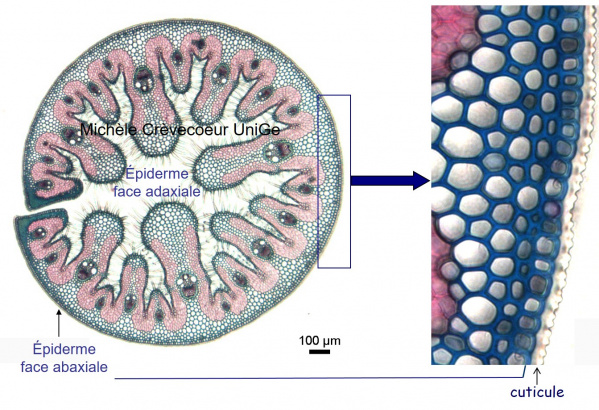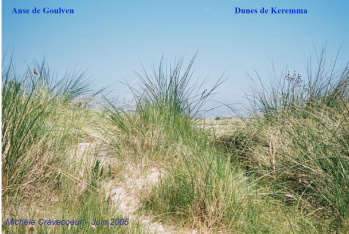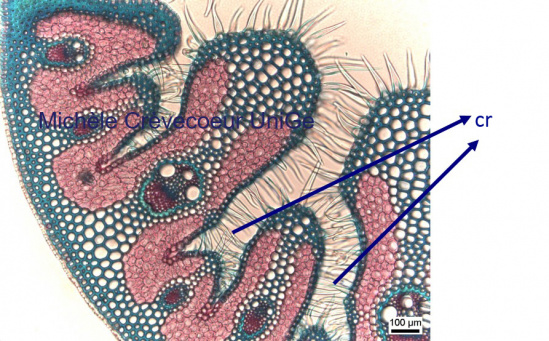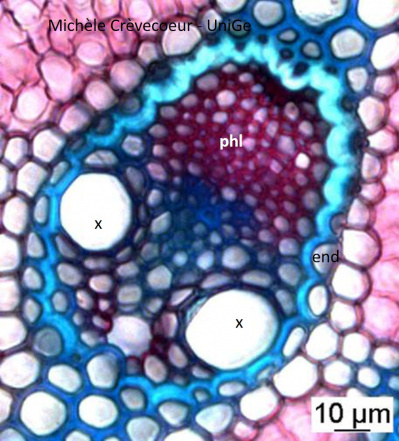Cross section in a leaf of Psamma arenaria – marram grass.
Psamma arenaria or Ammophila arenaria is a species of flowering plant in the grass family Poaceae, known by the common name’s marram grass. It is adapted to grow on sand dune and windy coasts, that corresponds to a dry environment: sandy soil that does not retain water and wind is often strong and dries the plants.
Marram grass is a xerophyte and belongs to the category of sclerophytes whose strategy is to limit as much as possible the loss of water by evapotranspiration. Leaves has the particularity to enroll to decrease the surface of transpiration in dry conditions (strong wind) and to unroll in wet conditions.
Many anatomical characteristics of the leaf perfectly reflect the adaptation of this plant to water stress in its natural environment. They are illustrated on the cross sections below in which lignified tissues are stained blue – green and tissues with cellulosic walls are stained pink. The cuticle and the trichomes are not stained and appear white.
Below: aspect of a cross section in an enrolled leaf. On the right detail of epidermis of abaxial face with its thick cuticle (in white) and absence of stomata and below the epidermis several layers of cells with highly lignified walls (sclerenchyma).


Dunes in Keremma, North Finisterre – Bretagne (FR) in Tréflez and Plounévez-Lochrist municipalities. It is the largest cordon of dunes in Britain (5 kms long, 500 to 1000 meters large and an area of 200 ha).
Below: part of the cross section showing crypts on the adaxial epidermis (cr : blue arrows) with a high density of long trichomes whose function is to keep humidity inside the enrolled leaf. The epidermis of this face has a thin cuticle.


Below : part of the cross section showing bulliform cells, located at the base of the crypts. These specialized cells of epidermis of the adaxial face are larger than other epidermis cells and their walls are cellulosic (pink arrow and pink circle). They control the enrolling of the leaf: in dry conditions the bulliform cells become plasmolyzed and the leaf enrolls; in wet conditions they are turgid and cause unrolling of the leaf.

On the left: detail of a vascular bundle with phloem (phl) and xylem (x) and a pseudo endodermis (end) constituted of U cells. The xylem vessels have a V distribution with the tip towards the adaxial face and the phloem is located toward the abaxial face.
Three anatomical characteristics correspond to a monocotyledon: (1) vascular bundles distributed on a row and corresponding to parallel veins; (2) distribution in V of xylem with phloem between arms of the V; (3) pseudo endodermis with U cells around vascular bundles.
Many anatomical characteristics of the section correspond to a sclerophyte well adapted to dry environment : (1) thick cuticle of the epidermis of the abaxial face to prevent too important loss of water by evapotranspiration and to protect the leaf from radiations; (2) bulliform cells of the adaxial epidermis to allow enrolling of the leaf, decreasing greatly the surface exchange with outside and limiting water loss by evapotranspiration; (3) crypts with high density of trichomes on the adaxial face; (4) abundant sclerenchyma in the mesophyll: it ensures mechanical protection of the plant against grains of sand; it gives support to the plant and allows it to resist to the windy conditions of ocean borders; (5) absence of stomata on the epidermis abaxial and their presence on the adaxial face (enrolled), protected in crypts.